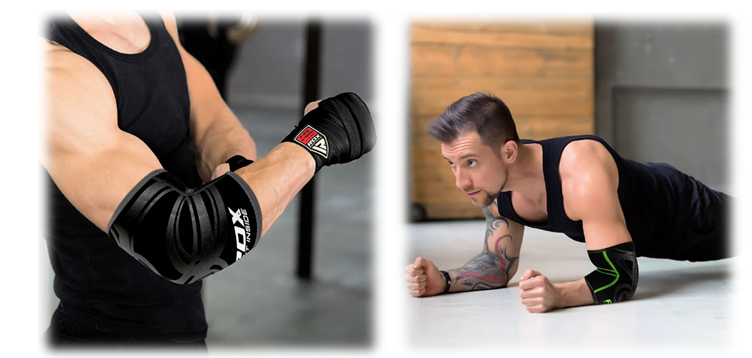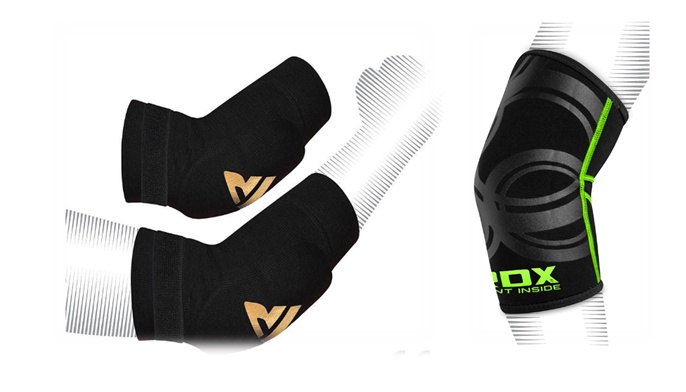Elbow supports are pivotal for individuals seeking relief from discomfort or aiming to prevent injuries during physical activities. Whether you're an athlete, fitness enthusiast, or recovering from an elbow ailment, finding suitable elbow support can significantly improve your comfort and performance.
Exploring Different Types of Elbow Support:
- Elbow Sleeves:
These lightweight, flexible garments provide compression and warmth to the elbow joint, ideal for individuals with mild to moderate discomfort seeking extra support during physical activities.
- Elbow Braces:
Offering greater stability with adjustable straps or hinges, braces are recommended for those recovering from injuries or dealing with chronic elbow conditions requiring immobilization.
- Elbow Straps:
Also known as tennis elbow straps, these target specific areas of the forearm to alleviate tension on affected tendons, commonly used to treat conditions like tennis elbow or golfer's elbow.
Benefits of Using Elbow Support:
- Pain Relief:
Alleviate discomfort and inflammation associated with various elbow conditions, enabling engagement in daily activities or sports with reduced pain.
- Injury Prevention:
By providing stability and limiting excessive movement, elbow support can prevent overuse injuries or recurring strains, especially during high-impact sports or repetitive tasks.
- Support During Physical Activities:
Enhance performance and diminish the risk of overloading the elbow joint while lifting weights, playing sports, or performing manual labour.
Selecting the Right Elbow Support:
Choosing the appropriate elbow support is crucial for maximizing comfort and effectiveness during various activities. Here are some key considerations to help you select the right elbow supports:
- Activity Type:
Consider the specific activities you'll be engaging in while wearing the elbow support. Different types of support are designed for varying levels of impact and movement. For example, if you're participating in high-impact sports like basketball or rugby, you may need a more robust brace with adjustable straps for added stability. On the other hand, if you're primarily looking for mild compression and warmth during weightlifting or yoga, a sleeve may suffice.
- Sizing and Fit:
Ensure the elbow supports fits snugly without being too tight or restrictive. Measure the circumference of your forearm and compare it to the sizing chart provided by the manufacturer. Pay attention to any adjustable straps or closures that allow you to customize the fit for optimal comfort and support.
- Material and Durability:
Look for elbow support made from high-quality, breathable materials that provide adequate compression without causing discomfort or irritation. Consider factors such as moisture-wicking properties to keep sweat at bay and durability to withstand regular use without losing elasticity or supportiveness.
- Comfort and Range of Motion:
Choose elbow support that allows for comfortable movement without hindering your range of motion. Avoid overly rigid braces that restrict flexibility, especially if you require mobility for sports or activities that involve dynamic movements like throwing or swinging.
- Condition and Injury Type:
Take into account any existing elbow conditions or injuries that may require specific types of support. For example, if you're recovering from tendonitis or arthritis, a compression sleeve or strap may help alleviate pain and inflammation. Consult with a healthcare professional if you're unsure about the most suitable type of support for your Condit
- Reviews and Recommendations:
Read reviews and seek recommendations from trusted sources, such as healthcare professionals or fellow athletes, to gather insights into the effectiveness and comfort of different elbow supports options. Real-life experiences can provide valuable guidance in making an informed decision.
By considering these factors and selecting elbow support tailored to your needs and preferences, you can enjoy enhanced comfort, stability, and performance during various activities while minimizing the risk of discomfort or injury.

When to Wear Elbow Support:
Knowing the appropriate times to wear elbow support can help optimize its benefits and enhance your comfort and performance. Here's when it's advisable to wear elbow supports:
- During Sports and Exercise:
Wearing elbow support during sports and exercise activities can provide added stability and protection to the elbow joint, reducing the risk of injuries and strains. Whether you're playing tennis, golf, weightlifting, or participating in contact sports like football or basketball, wearing elbow support can help support the muscles and tendons around the elbow, minimizing the risk of overuse injuries or sudden impacts.
- While Performing Repetitive Tasks:
If your work or daily activities involve repetitive motions that place strain on the elbow joint, wearing elbow supports can help alleviate fatigue and prevent overuse injuries. This is particularly relevant for individuals who engage in jobs or hobbies that require frequent bending, lifting, or gripping motions, such as construction workers, painters, gardeners, or musicians.
- After Injury or Surgery:
Following an elbow injury or surgical procedure, wearing elbow support during the recovery phase can aid in stabilization, pain management, and promoting healing. Whether you're recovering from a fracture, sprain, tendonitis, or undergoing rehabilitation after surgery, wearing elbow supports as recommended by your healthcare provider can provide additional support and protection to the injured area, facilitating a speedier recovery process.
- During Activities with Increased Strain:
If you anticipate engaging in activities that place increased strain or stress on the elbow joint, such as heavy lifting, repetitive overhead movements, or prolonged periods of computer use, wearing elbow supports can help alleviate discomfort and reduce the risk of overuse injuries. By providing compression and support to the muscles and tendons, elbow supports can help distribute forces more evenly, reducing strain on the joint and minimizing the risk of fatigue or injury.
- As a Preventive Measure:
Even if you're not currently experiencing elbow pain or discomfort, wearing elbow support preventively during high-risk activities or sports can help proactively protect the joint and minimize the risk of future injuries. By providing additional stability and support, elbow support can help enhance your confidence and performance while reducing the likelihood of overuse injuries or strain.
By wearing elbow supports during these appropriate times, you can effectively mitigate the risk of injuries, alleviate discomfort, and enhance your overall comfort and performance during various activities.
Proper Use and Maintenance of Elbow Support:
When it comes to using and maintaining elbow support, following best practices ensures optimal performance and longevity of the product.
- Putting On and Taking Off:
Follow the manufacturer's instructions carefully when putting on or taking off elbow support. Ensure a snug yet comfortable fit without excessive tightness that may restrict blood flow or cause discomfort.
- Cleaning and Care:
Regularly clean your elbow support to remove sweat, dirt, and bacteria that can accumulate during use. Hand wash with mild detergent and lukewarm water, and then allow it to air dry thoroughly before wearing again. Avoid using harsh chemicals or bleach, as they may degrade the fabric and reduce the support's effectiveness over time.
- Inspect for Wear and Tear:
Periodically inspect your elbow supports for any signs of wear and tear, such as fraying seams, stretched elastic or worn-out straps. Replace the support if you notice any damage or deterioration that compromises its stability or comfort.
- Storage:
Store your elbow support in a cool, dry place away from direct sunlight, heat sources, or moisture. Avoid folding or creasing the support excessively, as this can damage the fabric and affect its compression properties.
- Avoid Overuse:
While elbow supports can provide relief and stability, avoid wearing it for prolonged periods without breaks. Overuse may lead to dependency on the support and weaken the muscles around the elbow over time. Use elbow support as needed during activities that place stress on the joint, but allow your elbow to move freely during rest periods.
By following these guidelines for proper use and maintenance, you can ensure that your elbow support remains effective and comfortable for extended use, helping you stay active and injury-free.
Conclusion:
Elbow support plays a vital role in enhancing comfort and performance for individuals dealing with elbow pain or seeking injury prevention during physical activities. By understanding the different types of support available and selecting the right one based on activity and fit, individuals can effectively manage discomfort and optimize their performance.


No comments yet